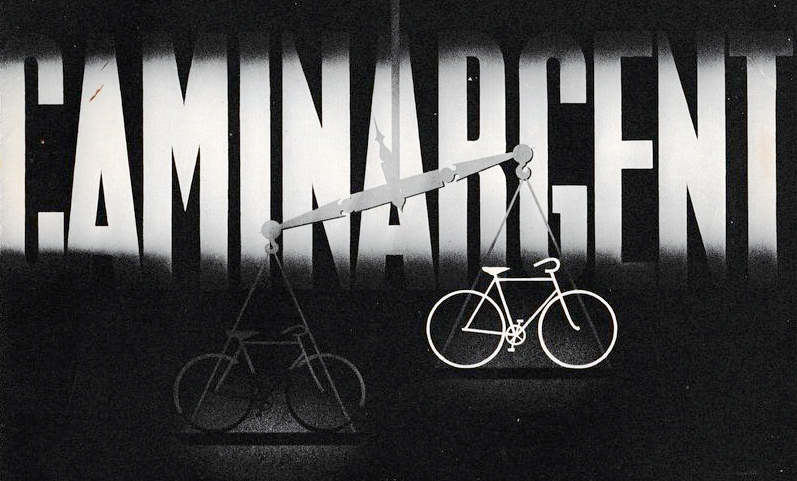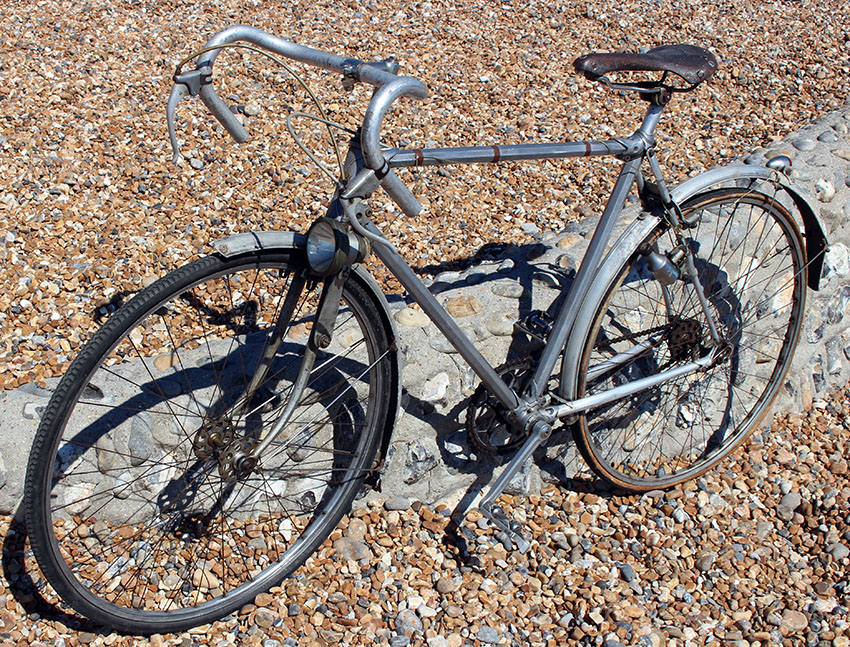Click here to view at The Online Bicycle Museum
Duralumin: strong, hard, lightweight alloy of aluminum, widely used in aircraft construction, discovered and patented in 1910 by Alfred Wilm, a German metallurgist; it was originally made only at Düren in Germany. The original composition has been varied for particular applications; it may contain about 3 or 4 percent copper, 1/2 to 1 percent manganese, 1/2 to 1 1/2 percent magnesium, and, in some formulations, some silicon. After heat treatment and aging, these alloys are comparable to soft steel in strength.
Duralumin alloys are relatively soft, ductile, and workable in the normal state; they may be rolled, forged, extruded, or drawn into a variety of shapes and products. Their light weight and consequent high strength per unit weight compared to steel suit them for aircraft construction. Because duralumin loses strength in welding, a special laminated sheet form called Alclad is used for aircraft construction; it has thin surface layers of pure aluminum or a corrosion-resistant aluminum alloy covering the strong duralumin core.
The CAMINARGENT is light and strong.
The CAMINARGENT is neither brazed nor soldered.
The CAMINARGENT is neither enamelled nor nickel plated.
The CAMINARGENT is made entirely from French materials.
From the earliest days, cycle manufacturers provided racing cyclists with special frames of lighter weight and their racing successes helped to sell the companies’ products to the public who, like the racers, rode fixed wheel machines with minimal braking systems. Racers were prepared to dismount on steep hills. By the turn of the 20th century, however, cycle enthusiasts were starting to ride longer distances, in any weather, and a need arose for machines to suit. In France, these cyclotourists – at the beginning known as the ‘School of St Etienne’ – asked the manufacturers for lightweight bicycles with multiple gears and, by the 1920s, bicycles were built to cater to this market.
In the thirties, some small French firms – ‘constructeurs – started to specialise in custom-built lightweight machines, making perhaps only a few dozen such machines a year that cost the equivalent of three months professional wages. This was the heyday of French styling, when bicycles were treated with the same respect given to works of art. Duralumin was a practical choice of metal for such machines.
Combined with copper, manganese and magnesium, the strength of aluminium was comparable to steel, and it became popular in the late 1930s in France for building bespoke bicycles. The aluminium frames were not soldered or welded but the tubes are fitted into lugs by screwing, pressing or glueing. As a result, very light weights could be achieved.
1936-38 Caminade Caminargent
Duralumin (Aluminium) Bicycle
British agent: Hicking Cycles, Station Approach, Hayes, Kent
21″ Frame
26″ Wheels
Frame No 508
(Now sold)
DANS SON JUS: Most Caminargents I see are highly polished and photographed with studio backgrounds, either for sale or display. This machine was ridden regularly by its previous owner and then put into storage for many years. Maybe the age of its pedals are an indication of when it was last ridden? Collectors dream about coming across such a treasure ‘dans son jus’.
HOW THINGS REALLY WERE: As is common with these bicycles, the aluminium front fork has been replaced with steel. In these photos, taken last week, it doesn’t have a Caminargent handlebar & stem; but I’ve just bought one, and added photos further down the page. The cable is held on with tape rather than cable clips. It needs a new set of tyres (26 x 1 1/4″) to be ready for the road. Although I enjoy finding interesting parts to make a beautiful bicycle even prettier, don’t all the over-restored show bikes alter our perspective of how things really were? So here’s a top-of-the-range machine used for its original purpose …riding 🙂
![]()
CAMINARGENT HANDLEBAR / STEM

1937 HICKING CAMINARGENT CATALOGUE EXTRACTS


With their distinctive octagonal tubes and ornate cast lugs, the Caminargent was expensive to produce. This style of aluminium bicycle was made between the 1930s and 1950s, constructed from Alumag (a brand of aluminum-magnesium alloy) tubing held in place in the lugs by internal expanders. Duralumin is twice the strength of aluminium, despite being light in weight, and was originally designed for use in Zeppelin airships and early aircraft.
The Hindenburg had a duralumin structure, incorporating 15 Ferris wheel-like bulkheads along its length, with 16 cotton gas bags fitted between them. In 1931 the Zeppelin Company purchased 11,000 lbs of duralumin salvaged from the wreckage of the October 1930 crash of the British airship R101, which might have been re-cast and used in the construction of the Hindenburg.
Although aluminium bicycles were in use since the late 1890s, the Hindenburg disaster led to a surplus of duralinum, influencing its increased use in bicycle manufacture. After WW2, when steel use was reserved for export products, aluminium was more affordable and became the lightweight and tough material of choice for bicycle frames, especially in France.
![]()
* Airship info – http://edisoneffect.blogspot.co.uk/2011/02/airship-hindenburg-few-bits-and-pieces.html
Catalogues with thanks to the V-CC archive






























































Leave a Reply